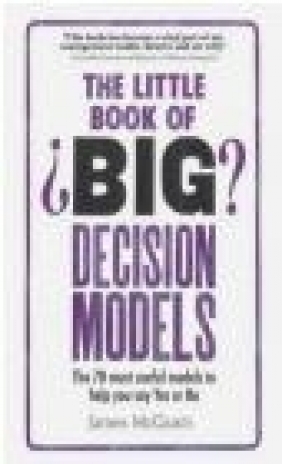The Little Book of Big Decision Models
Jim McGrath
The Little Book of Big Decision Models
Jim McGrath
- Producent: Pearson
- Rok produkcji: 2015
- ISBN: 9781292098364
- Ilość stron: 224
- Oprawa: Miękka
Niedostępna
Opis: The Little Book of Big Decision Models - Jim McGrath
Leaders and Managers want quick answers, quick ways to reach solutions, ways and means to access knowledge that won't eat into their precious time and quick ideas that deliver a big result. The Little Book of Big Decision Models cuts through all the noise and gives managers access to the very best decision-making models that they need to to keep things moving forward. Every model is quick and easy to read and delivers the essential information and know-how quickly, efficiently and memorably.About the author Acknowledgements Introduction How to get the most out of this book Chapter 1 - The principles of decision making Introduction Model 1: Townsend's rules of decision making Model 2: The McNamara fallacy - The vital information that decision makers ignore Model 3: Using quantitative (hard) and qualitative (soft) data in decision making Model 4: Kreiner and Christensen the consequence model Model 5: Tenenbaum and Schmid's decision making spectrum Model 6: Roger and Blenko's rapid decision making model Model 7: Cognitive mapping - understanding how your colleagues think Model 8: Tacit knowledge and decision making Model 9: The standard decision making model Conclusion Chapter 2 - Using data in decision making Introduction Model 10: The Pareto principle and the important vital few Model 11: Lewin's force field analysis of the support and opposition to a decision Model 12: Scenario analysis and charting possible futures Model 13: Delphic forecasting and how to firm up predictions Model 14: Johnson, Scholes and Wittingham mapping stakeholder's reactions Model 15: Egan's shadow side model - dealing with the politics of decisions Model 16: The SCAMPER model and finding creative solutions Model 17: De Bono's six thinking hats - generating different perspectives Conclusions Chapter 3 - Enhancing your decision making skills Intrduction Model 18: The Eisenhower principle and the delegation of decisions Model 19: The feedback and criticism grid Model 20: Learning to think outside the box Model 21: Goleman: Using emotional intelligence to make better decisions Model 22: Sumantra and Bruch reclaiming your job Conclusion Chapter 4 - Decisions models about you Introduction Model 23: Christensen's strategy for a happy life Model 24: The making - of you model and how your past influences the present Model 25: The rubber band model - what holds you back and pulls you forward? Model 26: The crossroads model and which road to follow next Model 27: The personal performance model and job satisfaction Model 28: Csikzenmihalyi's flow model and the joy of working in 'the zone' Model 29: Maslow's Pyramids - what you want and what you need Model 30: The Euffe Elbaek model - a guide to your personality Model 31: Johari windows - a guide to your personality Model 32: The personal potential trap and how to avoid becoming a prisoner of other peoples' expectations Model 33: Your attitude to risk Conclusion Chapter 5 - Decision Models about other people Introduction Model 34: Goffee and Jones - why should anyone be led by you? Model 35: Hersey and Blanchard's situational leadership model Model 36: Manzoni and Barsoux - how managers set staff up to fail Model 37: Denseraeu, Graen and Haga - how managers set staff up to succeed Model 38: Herzberg's motivation and hygiene theory - choosing the right carrots Model 39: The feedback sandwich - delivering negative feedback Model 40: McGregor's features of effective and ineffective teams Model 41: The team model - building a well balanced team Conclusion Chapter 6 - Strategic and market decision models Introduction Model 42: The standard product life cycle Model 43: The gap in the market model Model 44: The hype cycle market model Model 45: The long tale market model Model 46: The diffusion market model Model 47: Milgram's six degrees of separation model Model 48: Kim and Mauborgne's blue ocean strategy Model 49: Offshoring core activities Model 50: Moore's headpin theory Model 51: The Boston Consulting Group product analysis grid Conclusion Chapter 7 - Organisational threat analysis Introduction Model 52: SWOT - Done right! Model 53: PEST - Done right! Model 54: The unexploded bomb (UXB) model - unknown and unforeseen threats Model 55: Nicholas and Teleb's black swan model and unknowable threats Model 56: The black box model Conclusion Chapter 8 - Financial and statistical models Introduction Model 57: Risk reward analysis Model 58: Kaplan and Norton balanced scorecard Model 59: Discounted cashflow (DCF) - Calculating today's value of tomorrows returns Model 60: Cost benefit analysis - Accounting for non-financial factors Model 61: Breakeven analysis - knowing if you can reduce prices Model 62: Gap analysis - closing the gap between forecast and target Model 63: Zero based budgeting - making the right budget cuts Conclusion Chapter 9 - How to successfully implement your decisions Introduction Model 64: Round's TRAP model Model 65: Johnson's three rules of project management Model 66: Shewhart's plan, do, check, act (PDCA) implementation model Model 67: Orlandella and Reason's Swiss cheese model and how to stop problems escalating Model 68: Setting SMART targets that get results Model 69: Kim and Mauborgne's tipping point leadership - How to sidestep/overcome implementation problems Model 70: Cooperrider and Srivastva's appreciative inquiry model (A1) and the power of positivity Personal characteristic and how they can produce good and bad decisions The First 11 Team A Final Word Recommended reading
Producent:
GPSR Pearson Central Europe Sp. z o.o.
ul. Szamocka 8
01-748 Warszawa (PL)
tel: 459 596 060
email: [email protected]
Szczegóły: The Little Book of Big Decision Models - Jim McGrath
Tytuł: The Little Book of Big Decision Models
Autor: Jim McGrath
Producent: Pearson
ISBN: 9781292098364
Rok produkcji: 2015
Ilość stron: 224
Oprawa: Miękka
Waga: 0.34 kg




























